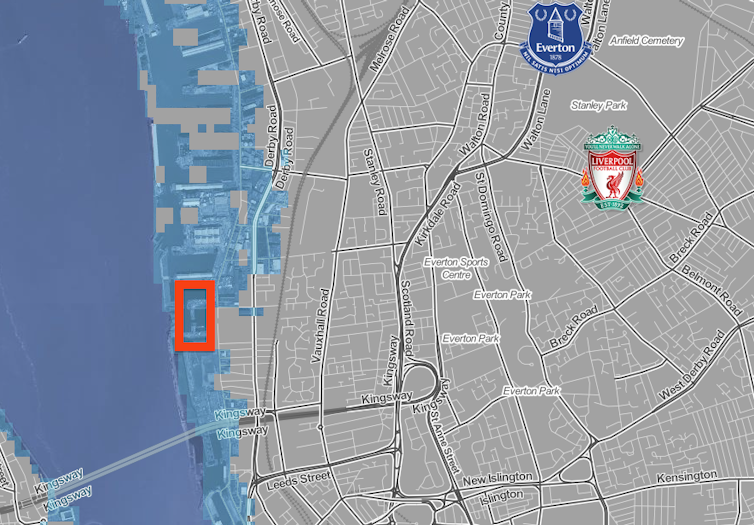New Everton football stadium could end up underwater thanks to global warming
Climate Change FC?
Tuesday, 2nd May 2017

Graeme Heyes, Manchester Metropolitan University
Everton Football Club announced a milestone step towards moving from its historic Goodison Park home to a new stadium at Bramley Moore dock in Liverpool.
When I saw this news my initial reaction was one of surprise. As a researcher in sustainable business models, surely spending £300m on a waterfront stadium is a significant risk in terms of sea level rise? Liverpool city centre, showing the two current football stadiums, and Bramley Moore dock (red box). After 2°C warming the light blue areas will eventually be permanently underwater.[/caption]
Liverpool city centre, showing the two current football stadiums, and Bramley Moore dock (red box). After 2°C warming the light blue areas will eventually be permanently underwater.[/caption]Football clubs can’t ignore global warming
Of course, this won’t happen any time soon and few businesses are required to think in such long terms. New buildings are generally not designed to last for centuries, partly because it’s rare for a firm to last that long. This is one of the reasons why climate change is such a complex challenge for society – it simply does not comply with the time-frames of political or corporate shareholder decision-making.
But football clubs are different. Everton was founded in 1878 and has been at its current home of Goodison Park for 125 years. It will still be around to see 2℃ warming and beyond.
Although increasingly operated like businesses, football clubs remain institutions that are deeply important to many communities. For millions of people they are “the most important of the less important things”. Football clubs owe it to these people to think in the longer term. Such thinking is starting to seep into the game. The popular book Soccernomics, for example, argues that a long-term footballing philosophy that underpins a club’s direction on the pitch, can prevent short-termism associated with changing managers every couple of years (something that politics too could benefit from).Climate Change FC?
A truly responsible football club should embrace the challenge of overcoming climate change. They could start by recognising their own role, for instance the significant transport emissions of people travelling to matches.I have conducted research in the past in which I benchmarked the environmental initiatives conducted by football clubs outside of the Premier League. While I found many clubs had carbon reduction initiatives typical of those found by leading “brands” in other industries, the majority had some way to go.
Considering most football clubs are effectively small and medium-sized enterprises, with few resources, this is perhaps to be expected. But it’s a missed opportunity. These clubs have the ability to engage with their communities on levels beyond that of perhaps even government or religion. They are already striving to do so on issues such as racism and homophobia. They should begin to highlight the climate change challenge too. Doing so could go a long way to justifying the increasing cost of following football, and could make a real difference in terms of our ability to mitigate the impacts of global warming.Everton hasn’t won a trophy since 1995. The club’s fans, desperate for success, could be forgiven if they don’t let the far off implications of climate change deter them from supporting a state of the art new stadium. But whether they will look on this development so favourably in the coming decades remains to be seen. One can only hope the developers of this new stadium have undertaken a full climate change risk assessment – or have stocked up on sandbags.
Latest
- Trinidad: Fire truck breakdown leaves 54-year-old Ian dead i...
-
Caribbean Five boost CBI Credibility with new residency requ... -
Bahamas sees 38% drop in homicides by mid-July 2025 -
Jamaica records 41% drop in Murders, lowest mid-year homicid... -
Tobago: Family blames hospital for electrician’s death after...






